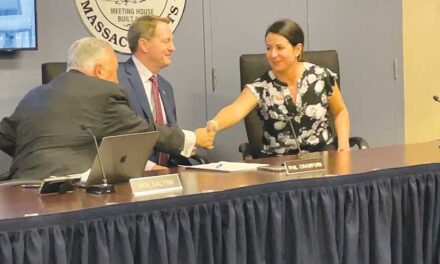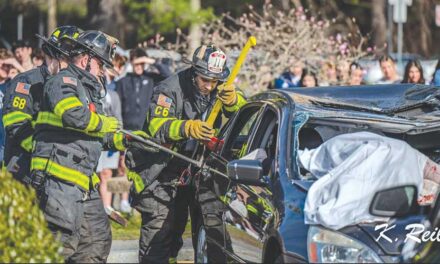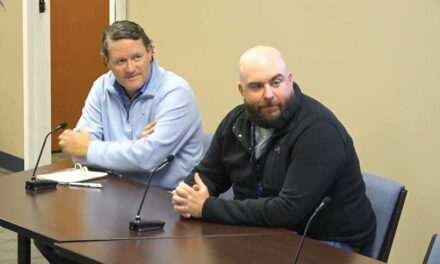Published in the February 1, 2017 edition
By MAUREEN DOHERTY
LYNNFIELD — Fire Chief Mark Tetreault is requesting a capital budget of $850,400 for Fiscal Year 2018, but with a caveat. He is not expecting it to be fully funded.
Tetreault explained to the board up front: “My capital is fairly long but keep in mind when applying for grants, if these items don’t appear on the capital sheet we have less of a chance of being funded for those grants. But I obviously don’t expect 100 percent funding.”
The chief prioritized the items on his list, starting with personal protective clothing for $15,000, for which the department has received grants in the past to offset the cost.
“Clothing has a 10-year shelf life and if we don’t purchase some clothing each year, we will be faced with a situation where they all expire in the same year,” he said.
His next priority is two specialized washing machines/extractors that enable particulates and potential cancer-causing agents to be extracted during the washing process. These cost $8,500 apiece. Ideally, he would like one for each station. But if that is not possible, he would like at least one. He has requested the machines each year during his tenure, but they have not been funded. He tried to get grant monies from two different sources last year, but was not successful.
Selectman Chris Barrett said he recalled the chief requested these machines last year, citing the need for firefighters to clean their equipment based on studies concerning the incidence of cancer among firefighters. “This is a safety issue and public health issue, correct?” Barrett asked. “That’s not so much a want, that’s a need. It’s well past its due.”
The chief agreed, adding he discussed this request with Town Administrator Jim Boudreau and the possibility of off-setting the cost with money that may be left over in the current year’s budget.
New ambulance: $250K
Tetreault has also requested a new ambulance at $250,000, hopefully to be funded from the town’s ambulance enterprise account. “I think our enterprise is in very good shape and we should have no problem supporting the first year of debt to replace Ambulance 2,” he said.
This 2001 model ambulance has 100,000 miles on it. “The inspector said that he didn’t want to see this ambulance again. We’re really at a critical point,” he explained.
The department’s capital replacement plan includes replacing one ambulance every five years, which works out to about $50,000 per year to finance.
“The 2011 (ambulance) would go to ‘second out status’ and the newest ambulance would run ‘first out’ for five years. So we’re replacing Ambulance 2 but we’re really taking Ambulance 1 out of first status,” he said. It will have close to 100,000 miles on it when the new ambulance would be put into service.
“By comparison, Ambulance 2, which is 15 years old, only has 102,000 miles on it, so the use has definitely increased,” he explained. The chief has also requested $26,000 for two replacement stretchers which date back to the 1990s and are not up to code. The inspector “barely passed” them he said. Tetreault was unsure why these stretchers were so old, because new ambulances are typically equipped with new stretchers, he said. But those purchases were made prior to his tenure. If funds are available from the Ambulance Enterprise Account, the cost would be shifted off his capital budget list, he said.
“We can only spend up to our appropriation or what we bring in for income,” he said.
Listed as his fourth funding priority is the replacement of three IV pumps for the ambulances totaling $14,400, however, he noted that the Massachusetts Fire Chiefs recently issued a bulletin advising departments not to buy them yet because “it is somewhat of an unfunded mandate from state. They’ve written a letter to governor stating if the state is mandating it, the state should pay for it,” Tetreault said.
Out-of-date AEDs
Tetreault said the department’s Automatic External Defibrillators (AEDs) are out of date and he is requesting a total of $15,000 to replace them. Of that expense, $4,500 would be spent for AEDs kept in police cruisers and $10,500 on AEDs for fire apparatus. These newer machines would be compatible with those currently used in the town’s ambulances.
Another $38,000 is requested to replace a staff vehicle and he has allotted $39,000 to cover the Fire Department’s share of the radio infrastructure equipment upgrade program in which fiber optic cable is being installed to replace copper. This is a shared expense with the Police Department and a multi-year process.
The ninth priority on his list was fire hose replacement at $5,000, but since no hoses were replaced last year, this expense becomes more necessary, he said.
He is also requesting $5,000 for the department’s information technology account to cover the as needed expenses related to maintaining and replacing the various computer laptops and tablets, computer programs and station status boards.
Tetreault is also requested $10,000 to update dispatch alarm receiving equipment.
The chief is also requesting $46,000 to replace a compressor and $260,000 for 40 airpack units.
“The life expectancy on airpacks is 10 years and next year is 10 years, so hopefully we can apply for a grant to replace those,” he said.
The last request in his capital budget is $110,000 to replace all of the mobile and portable radios. He applied for a grant last year that fell just “three percentage points shy” of obtaining it. So he “polished it up” and has resubmitted his request.
Tetreault said the ambulance enterprise account has about $40,000 in retained earnings from last year.
Selectmen Chairman Phil Crawford said this fund was set up “and designed to every five years have enough retained earnings to purchase a new ambulance. We obviously didn’t meet that goal,” but added with the new fee schedule hopefully that would improve in the future.
“If we have enough to split the first year’s debt on a lease purchase, that would be the way to go. We would need some level of certainty that we would be able to support that every year, not just this year,” the chief said.
“I’m optimistic it is going to be very favorable because we are up $60,000 halfway through the year,” he said, adding that that have not yet realized “the benefit of the new scheduling and we haven’t realized the benefit of the new billing company and of adjusting the billing rates,” Tetreault added.
“It makes sense,” Crawford said, “So between what you have now and what you see coming in, you should have plenty of money to handle the first year and if it keeps on that level you should be able to finance that. The bigger problem comes in five years from now.”
“In five years, we’d just roll it over again,” Tetreault said. “If we stay on the current trajectory, at some point, we should be able to buy one outright.”




